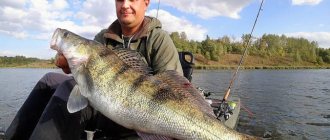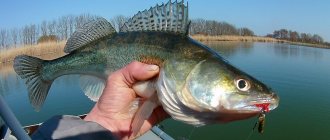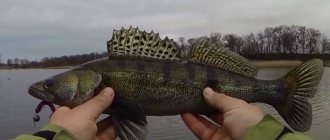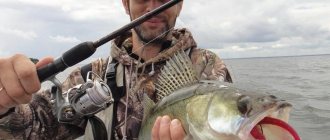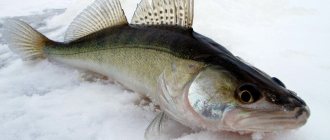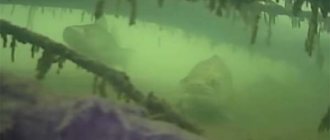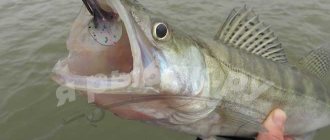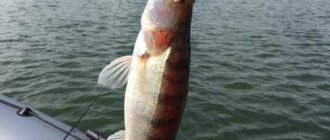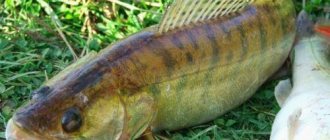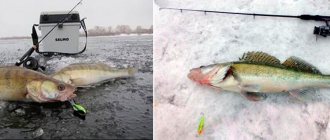Sliced fish - what is it?
Essentially, the bait is small pieces of fish meat. But not any fish is suitable for use, but only representatives of “white” breeds. Yes, and you definitely need to cut off a piece from the side. Its shape is not of fundamental importance. The main thing is that some scales remain on the cut fragment (the ideal option is a whole fin or a piece of tail).
Cuttings are used to equip bottom rigs, live bait fishing rods, as well as when fishing with mugs or other hooks. This bait attracts pike perch, large perch, catfish, burbot and pike well. Some fishermen say that individuals of the carp family, as well as trophy carp, showed interest in slicing.
Varieties of pike perch
Despite the common name, the designs of bottom gear for pike perch differ and this is due to the conditions of use and the baits used. Summer donks are tied on a fishing rod; for the winter version there is no need for it, since fishing is carried out in a hole.
There are three types of pike perch:
- summer;
- winter;
- live bait
Naturally, each angler modifies standard equipment options at his own discretion, but this is again due to the conditions of use.
Summer Donka
During summer fishing, the donka is cast over long distances, therefore it consists of:
- fishing rods;
- coils;
- braided cord;
- the actual installation of the donkey itself.
Rod
There are no hard and fast recommendations for choosing a fishing rod; the main thing is that the blank can withstand power casts and “knit” the fish well when playing. A budget option is a telescopic rod with rings, made of fiberglass or carbon fiber. The length of the form is from 2.70 to 3.60 meters, the lower ring with a diameter of at least 40 mm.
This is the minimum necessary option, and for comfortable fishing and complete confidence in the reliability of the gear, it is better to use a plug-in, two-part carbon fiber rod with a weight of up to 120 grams.
The weight of mounting a bottom with bait is usually less, but when fishing in the current you will need a heavy sinker and when casting forcefully the form experiences serious loads, and it is better if the weight is higher.
Coil
Everything is simple here - a spinning reel with a drag and a spool of at least 3000. Whether the drag will be front or rear is up to the fisherman to decide in accordance with his ideas about convenience.
Reels with front drag are more often chosen; they are more convenient to work with, especially if a trophy pike perch is hooked. The number of bearings in the reel does not play a decisive role, but it is better that they are metal, and one bearing is under the line roller.
Main line
The cord is used as the basis, since it is important:
- strength;
- inextensibility;
- durability.
In addition, a braided cord with the same breaking load is thinner than a monofilament line, and during power casts the equipment flies further. It’s better not to skimp on the cord, especially since with proper use it will last more than one season.
Fishing for donkey and pike perch is rarely carried out at a distance of more than 100 meters, so you will need less line than in feeder fishing or carp fishing.
Installation of summer pike perch donka
To make a summer donka rig for pike perch you will need:
- braided cord;
- monofilament line 0.25;
- triple swivel;
- single swivel;
- hook;
- sinker with swivel.
Tackle for pike perch must be sensitive, so both the base and most of the installation are knitted on a braided cord. A leash made of monofilament fishing line is made so that in case of a snag, only the hook comes off, which can be quickly re-tied.
It can be used as a main and monofilament line, but this is not the best option and this reduces the sensitivity of the gear.
Donka making process:
- tie a sinker to a 10–15 cm piece of braided cord using a swivel;
- on the other side of a piece of braiding make a loop;
- using the loop-to-loop method, tie a triple swivel vertically to the loop;
- attach a hook to a piece of fishing line 40–50 cm long;
- make a loop at the other end of the fishing line;
- tie the leash to the side arm of the triple swivel (loop to loop);
- on another 10–15 cm piece of cord, make two loops;
- insert a single swivel into one of the loops (loop-to-loop method);
- tie the second loop to the triple swivel;
- You tie a single swivel to the main fishing line (braided cord).
The result is a bottom tackle with a retractable leash, the length of which varies depending on the conditions and activity of the fish. The distance between the load and the triple swivel is made larger, but in this case the likelihood of snags increases even when landing fish, and I would like to avoid this.
Why is the installation not knitted on the main cord:
- in the event of a break, time is not wasted on tying a rather cumbersome installation, and in winter this is even more difficult to do;
- spare installations are always made to quickly replace broken equipment;
- It’s easier to disassemble the tackle after fishing, and the section of the bottom that was used for fishing is used on subsequent fishing trips.
Some fishermen believe that there should be several leashes with hooks, but with a length of 40-50 cm they will get tangled both when casting and when retrieving.
Important! It is not recommended to use fluorocarbon line for leashes; it is too stiff and will scare away trophy pike perch.
It is possible to install a feeder feeder instead of a sinker, but you need to select a feeder with a flat bottom and heavy weight. With this option, you will need a more powerful rod, because the heavy feeder is also filled with bait, and the weight of the rig becomes greater than the test weight.
How to improve installation
To improve and install a pike perch bottom, an anti-twist tube is used instead of a triple swivel. In this case, there is confidence that the long leash will not get tangled when casting, and the fish on the hook will not wrap it around a reed or branch in the water.
But at the same time, the tackle becomes coarser, which always scares away trophy fish, so you need to decide what is more important - the convenience of the fisherman, or the desire to catch trophy fish. Beginner fishermen are advised to install an anti-twist tube, at least at first, until they gain experience in properly casting and landing fish.
How to catch pike perch on a donka in summer
Unlike in winter, when the most important thing is to find fishing spots in advance, in summer exploratory fishing is carried out. If it is possible to study the topography of the bottom of a reservoir using an echo sounder, this will greatly simplify the search and increase the chances of catching trophy fish.
If this is not possible, you need to fish the selected sector, changing the distance and direction of fishing. After casting the tackle, the fisherman places the rod on a stand with a signaling device and waits for the fish to bite. Unlike other representatives of the ichthyofauna, pike perch bite sharply and in most cases self-hatch. But in any case, the fisherman needs to be careful so that the trophy fish does not drag the rod into the water.
You need to fish for pike perch slowly, but also without letting it go into snags or reeds. The correct setting and operation of the reel’s clutch helps here, because when there is strong pressure from the fish, it is better to let the line go. But at the same time, you must not give in to slack, because thanks to powerful jerks, the pike perch may well break the equipment, or wrap it around an underwater obstacle. Then you will have to break the tackle, or swim in a boat and still try to save the fish.
The following is used as a bait for bottom tackle for pike perch in summer:
- worms, purulent (California red worm) and river;
- barley shell;
- frog legs;
- leeches;
- maggots;
- crayfish meat;
- dead fish;
- live bait
It is believed that live bait is the best bait for catching predatory fish, and pike perch is no exception in this regard, but in the summer it confidently bites other animal baits and baits, so you need to try everything.
The following are used as live bait for bottom fishing for pike perch in summer:
- bleak;
- roach;
- small crucian carp;
- bull;
- guster.
There is no need to place a fish that is too large; it will make it more difficult to cast the tackle and you will not achieve any better results. The fish is hooked behind its back, which gives it the opportunity to move and attract a predator.
Perch and even pike are caught on pike perch summer donkeys, but there is little chance of pulling out a toothy beauty, because it can bite a fishing line or cord. For pike you need metal or fluorocarbon leashes, and the tackle is somewhat different.
Important! It has been verified that trophy fish often take small baits that do not cause concern. The best bait for pike perch is small crucian carp.
How to plant correctly
When catching pike perch using cut fish, a piece of “fresh meat” needs to be pierced several times with a hook in different places. The tip can be hidden in the thickness of the meat, or it can be left open.
- This is interesting! Experienced fishermen say that cutting with scissors produces especially good results. In this way, you can create the effect of a certain “bittenness”, which attracts predators.
The good thing about cutting fish is that there are much fewer idle bites. When baiting the tackle, the hook should be threaded twice through the thick front end of the thread, and then secure the bait with a small piece of rubber.
Why is catching pike perch from the shore using cut fish so effective? The fact is that a predator, seeing a bitten piece of fish, thinks that someone has lost his trophy, and also believes that the easy prey is wounded, that is, it will not be able to swim away quickly. Therefore, pike perch rushes to the bait with great enthusiasm. All that remains for the fisherman is to make a competent and timely hook.
Live bait for pike perch
Catching pike perch with live bait is a passive hunting method, but ultimately no less effective than other types of fishing. Live bait fishing is divided into two seasons: in open water and from ice. For live bait fishing in open water, float gear, girders, mugs are used, and bottom fishing techniques are also adapted. From the ice they fish with winter girders, better known as flags or stakes, as well as with stavkas. It is more convenient to fish with live bait from the shore using a float rod; for fishing with mugs, you will definitely need a boat.
Almost any small fish is suitable as bait, but fish species familiar to pike perch and included in its diet are more promising. This type of live bait includes bleak and roach. It is these fish that form the basis of the pike perch food supply in any body of water. The loach is ideal for a stationary girder installed for a long period of time. Ruff, perch, gudgeon and goby are used as live bait in places where they are widespread, which increases the likelihood of their inclusion in the composition and nutritional norm of a predator. Winter pike perch donka supply and stock are supplied with small crucian carp, which are easier to store and live longer on the hook than any other fish.
Artificial slicing
Artificial baits made of edible silicone are a very convenient solution for exciting fishing. True, there is one drawback - these models are too expensive. However, cunning fishermen found a way out - they began to make slices from edible rubber. A large worm or twister is suitable for this purpose. This is a passive bait, so the angler’s task is to create the most natural game possible by moving the tip of the spinning rod at the moment when the bait lies on the bottom.
This is a budget and very catchy option that shows good results. Artificial cutting made from edible silicone will help out when it is not possible to use meat from “white” fish. At the Sazanya Bukhta fishing base you have the opportunity to experiment with gear and bait. Moreover, there are experienced huntsmen nearby who know when and how to catch predators.
TAGS:
Tags
Carp Buffalo Spring Vobla Asp Winter Crucian Rudd Summer Fishing baits Lower Volga Perch Autumn Fisherman's reminder Lures Bite forecast Fishing in Astrakhan Fishing baits Fishing tackle Fishing secrets Catfish Fishing methods Pike perch Catch Pike
